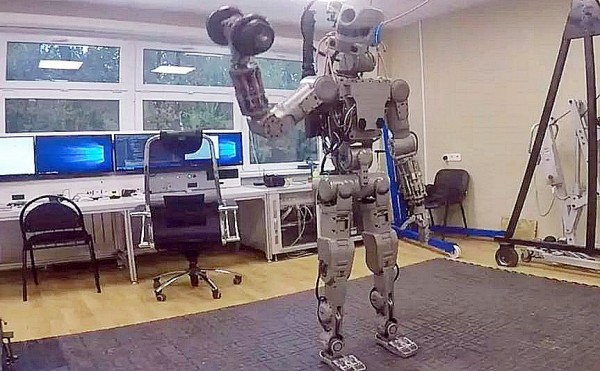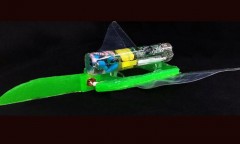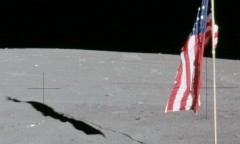By Arthur Dominic J. Villasanta , | April 14, 2017

Russia's F.E.D.O.R. robot lifting a dumbbell.
Only in Russia. The Russians have taught a humanoid robot intended to land on the Moon before the first Russian cosmonauts fire pistols with both its metal hands.
The sight of the Russian robot F.E.D.O.R. unleashing 9 mm rounds quickly reminds one of the Cyberdyne Systems series T-800 Model 101 Terminator played by Hollywood action star Arnold Schwarzenegger in the hit 1984 movie, The Terminator.
Like Us on Facebook
F.E.D.O.R., which stands for Final Experimental Demonstration Object Research, is a humanoid robot designed to accompany Russian manned space missions such as those to the Moon. It can operate a drill; drive a car; turn a wheel and even do push-ups
F.E.D.O.R. will fly into space in 2021 but is now capable of firing a pistol with both arms, according to Deputy Prime Minister Dmitry Rogozin.
"The robot of the F.E.D.O.R. platform showed skills of firing using both arms. Currently the work on fine motor skills and decision algorithms is underway," tweeted Rogozin.
Rogozin said training F.E.D.O.R. to shoot is a way of teaching the robot to instantaneously prioritize targets and make decisions.
"We are not creating a Terminator but artificial intelligence which will have a great practical importance in various fields," he explained.
It is expected F.E.D.O.R. will help astronauts work in outer space and serve aboard Russia's planned space station. Russia earlier reported the first flight of the Russian next-generation super-heavy launch vehicle will be guided by F.E.D.O.R.
"The unmanned launch and autonomous flight of our new spacecraft will take place in 2021 ... It is expected, and all relevant decisions have already been made, that robot F.E.D.O.R. will be the first pilot," said Yevgeny Mikrin, Roscosmos general designer of the manned spacecraft.
Russia's super-heavy launcher named "Federation" will have a payload of 80-85 tons in the first phase of the program. A pair of these rockets should be enough to mount a lunar expedition. Construction is expected to be completed by 2021.
In the second phase, the rocket will be upgraded to carry 130-180 tons of payload to support permanent lunar bases, missions to asteroids and expeditions to Mars.
The super-heavy rocket is also being built to deliver 15 ton military payloads such as large communication satellites and electronic warfare satellites to geostationary orbit.
-
Use of Coronavirus Pandemic Drones Raises Privacy Concerns: Drones Spread Fear, Local Officials Say

-
Coronavirus Hampers The Delivery Of Lockheed Martin F-35 Stealth Fighters For 2020

-
Instagram Speeds Up Plans to Add Account Memorialization Feature Due to COVID-19 Deaths

-
NASA: Perseverance Plans to Bring 'Mars Rock' to Earth in 2031

-
600 Dead And 3,000 In The Hospital as Iranians Believed Drinking High-Concentrations of Alcohol Can Cure The Coronavirus

-
600 Dead And 3,000 In The Hospital as Iranians Believed Drinking High-Concentrations of Alcohol Can Cure The Coronavirus

-
COVID-19: Doctors, Nurses Use Virtual Reality to Learn New Skills in Treating Coronavirus Patients










